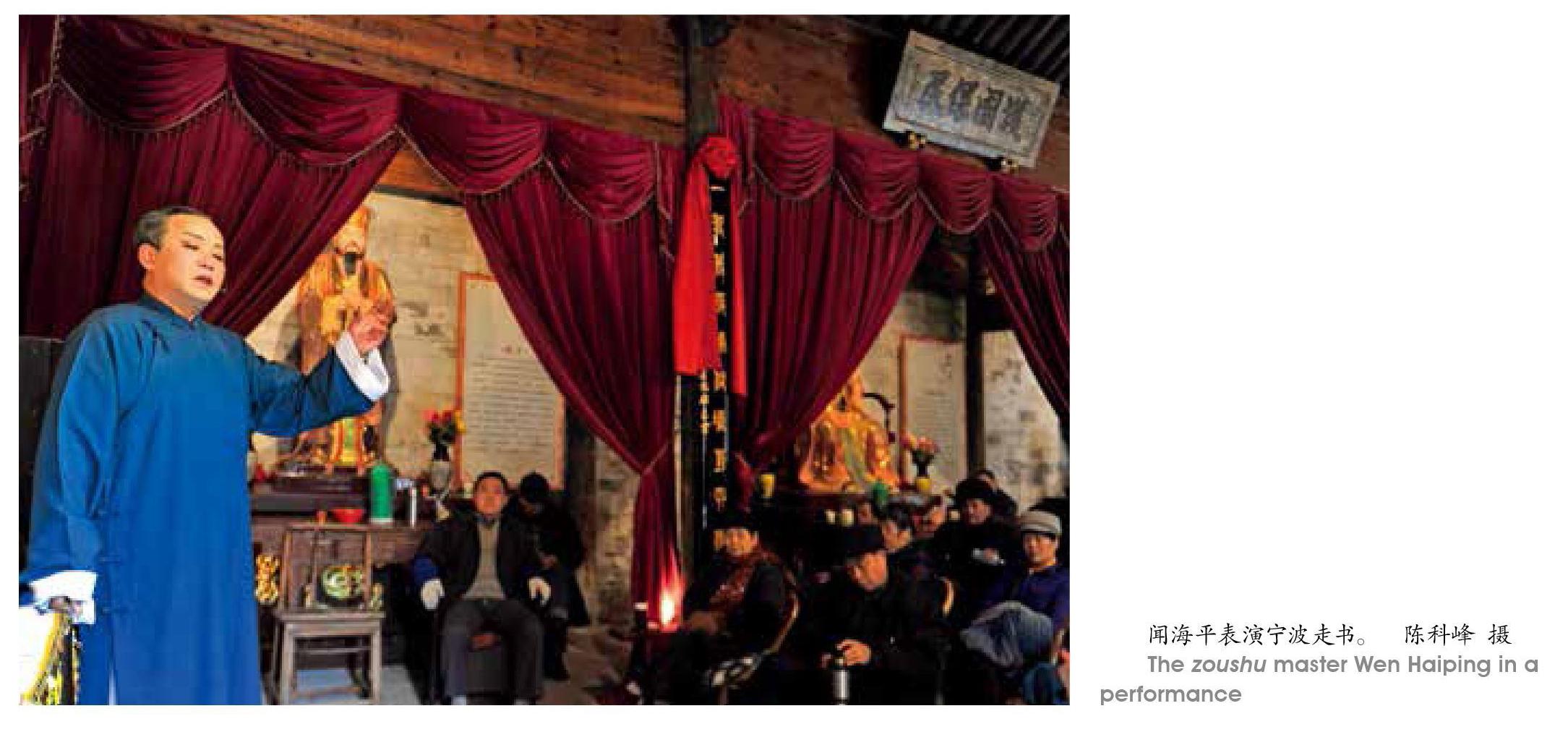南词?走书?评话,宁波人的乡音艺术
周东旭



一
曲艺是中国一门古老的说唱艺术。许多人分不清楚戏曲与曲艺,其实两者是传统艺术中一枝树上的两朵奇葩,有点“近亲”关系。曲艺是说唱艺术,而戏曲是扮演艺术,戏曲的许多声腔来源于曲艺,比如宁波甬剧的许多调腔,就吸收了四明南词的音乐;当年嵊县的落地唱书艺人涂脂抹粉,在4个翻过来的稻桶上铺上木板当作舞台,开始扮演人物,演出简单的小戏,从此诞生了一个名叫越剧的新剧种。
曲艺历史悠久。曾经出土过两汉时期的说唱俑,说唱俑一手抱着鼓,一手拿着槌,表情生动而滑稽。中国文学里的唐传奇、宋话本,与曲艺关系密切。“列位看官”“欲知后事如何,且听下回分解”,话本小说就是说书人的底本。《说唐》《说岳》均来自古代的说唱艺术,说书人根据这个底本加以发挥。
清代文学家、戏剧家李笠翁说,书是写给识字人看的,而戏则是演给识字和不识字的人看的。在旧时代,文化艺术、人文教养的提高,戏曲与曲艺起着非常重要的作用,以前教育普及率低,加之劳作辛苦,娱乐项目极少,而且曲艺比起戏曲,更不讲究场地和排场,几乎随时随地都可以演出,所以曲艺深受百姓欢迎。
明末文学家张岱描述过同时代著名评话艺术家柳敬亭说书的盛况,“一日说书一回,定价一两。十日前先送书帕下定,常不得空。”这里有当时最有名的说书艺人演出时的行情价格。同样是说景阳冈打虎,“与本传大异。其描写刻画,微入毫发”,说武松到了店门口大吼一声,店中的酒瓮都嗡嗡有声,“闲中著色,细微至此”。“其疾徐轻重,吞吐抑扬,入情入理,入筋入骨”,描绘了柳敬亭说书的高超艺术,同时记录了当时的说书盛况。
晚清的刘鹗在《老残游记》里有一段“明湖居听书”,也十分经典。“唱了十数句之后,渐渐的越唱越高,忽然拔了一个尖儿,像一线钢丝抛入天际,不禁暗暗叫绝。那知他于那极高的地方,尚能回环转折。几啭之后,又高一层,接连有三四叠,节节高起。恍如由傲来峰西面攀登泰山的景象:初看傲来峰削壁千仞,以为上与天通;及至翻到傲来峰顶,才见扇子崖更在傲来峰上;及至翻到扇子崖,又见南天门更在扇子崖上:愈翻愈险,愈险愈奇。”刘鹗用了通感手法,描写了唱书艺人的高超。
从现代的角度来看,曲艺已经式微,但细心一想,曲艺并不曾离开你的生活,在热播电视剧《都挺好》里苏大强就喜欢听苏州评弹,在喜马拉雅平台上的说书栏目,是许多人睡前的必修课。近来走红的“脱口秀”节目,类似单口相声,其实也有曲艺的影子在,只是脱口秀门槛要求低,无需说学逗唱的基本功训练,但一个一个的段子一如相声的“抖包袱”,这一点是舞台艺术的共通点。
二
宁波有许多曲艺品种列入国家级非遗项目,如四明南词、宁波评话、宁波走书、唱新闻等。
宁波有一句老话叫“南词唱华堂,走书下农庄,评话进茶坊”,这里就包含了宁波的三种曲艺:四明南词、宁波走书、宁波评话。从他们各自演出场所的不同,我们也可以看出四明南词相对比较文雅,出入于大户人家的厅堂;走书通俗易懂,是农民兄弟喜欢的节目;评话讲的都是历史故事,适合在茶坊里喝茶的男人们听,他们最关心历史政治故事。不同的演出形式,有不同的观众群,这是一种艺术形式繁荣的现象。
四明南词是唱、奏、念、白、表相间的表演形式。主唱人要有“一白、二唱、三弦”的硬功夫。南词常用曲调有词调、赋调、正赋、平湖、紧平湖,俗称“五柱头”。调和调式转换较多,也有板腔变化,曲调文静优美。唱腔大多是七字句,有的间隔衬字流畅动听。还有大段起板、间奏、尾奏等器乐段。在开演之前或休息之后必奏一曲,以显示该班社的艺术水平,并起到静场的作用。所用曲子多为江南丝竹乐曲,如《四合如意》《得胜令》《三六》等,最具特色的是四明南词独有的《将军令》(也称《文将军》)。主要乐器有:小三弦、扬琴、二胡、琵琶、箫、笙等。演奏时,演奏员们各显身手,配合默契,十分优雅。
四明南词的主要書目有:《珍珠塔》《玉蜻蜓》《白蛇传》《双珠球》《十美图》《盘龙镯》《雪雨亭》《果报录》《双珠凤》《西厢记》等。
我先前曾在宁波海曙区文化馆工作过一段时间,海曙区文化馆是四明南词的传承基地。当时的一位副馆长陈祥源先生即是四明南词的传承人,他学的是扬琴,他的妻子陈雅芸弹唱。文化馆组织群文综艺演出时,也常常能听到四明南词,但大都是开篇,唱上一段,如《阿拉宁波欢迎你》《悠悠青蒿》(说的是屠呦呦的故事),至于长篇的书目,则少有人演唱了。今年疫情期区,我在小区门口参加抗疫值班,碰上陈先生,和他聊了许多关于南词传承的问题。南词虽然文辞优雅,曲调优美,但现今的传承人几乎就是新中国成立后艺校专业培养的一批,现在文化部门虽然也举办一些公益类的培训,但十年树木,百年树人,速成也难。要培养人才,须投入大量人力物力和资金,而且希望艺校专业培养,不然终成广陵散。目前看来不如苏州评弹发展得好。
三
在2016年“东亚文化之都”评选活动中,中国的宁波、日本的奈良、韩国的济州三城入选。为了祝贺,在宁波天一阁状元厅演出了宁波走书《牡丹灯》,演出时间仅半小时,让许多观众感觉意犹未尽。我由此认识了走书艺人闻海平先生。
《牡丹灯》是元末明初钱塘才子瞿佑在《剪灯新话》里的一篇小说,是一个类似倩女幽魂的故事,发生在宁波月湖。虽然这个故事在本地已鲜为人知,但流传至日本、朝鲜后,影响深远。在日本,通过各种艺术的传播和改编,几乎人人知晓,成为日本的“三大怪谈”之一。因为这一层缘故,所以选择这个故事,改编成演出样式相对简单、又有地方特色的宁波走书来演出。把剧本和故事梗概给了闻海平先生之后,闻先生又根据走书特色进行了编排。从这之后,《牡丹灯》也成了闻海平先生的一个保留曲目。2020年10月,闻先生也参加了“融入现代生活,弘扬时代价值——2020全国非遗曲艺周四进演出”,在故事发生地宁波的月湖街道讲述了这个宁波故事。
从事宁波走书的艺人,是3种曲艺里最多的。相比南词,走书更通俗,说唱形式简单;相比评话,走书则多了一把胡琴伴奏,有唱腔有音乐,更能让人感受音乐唱腔的魅力。
寧波走书,又名莲花文书(犁铧文书),流传于宁波、舟山、台州一带。走书的表演形式比较灵活,常常是一演员一伴奏,后来也有双档分角色说唱。走书的曲调,常用的有四平调、马头调、赋调三种,俗称“老三门”。有时也用还魂调、词调、二簧、三顿、三五七等。“四平调”一般作为一部书的开头,末句常由乐队和唱,有点类似帮腔。赋调随内容情节、人物性格有紧、中、慢之分。如慢赋调节奏缓慢,曲调下行为主,多用于哀诉之类的叙述或回忆。
宁波走书的代表书目有:《白鹤图》《黄金印》《十美图》《玉连环》《双珠球》《包公案》《狄青平西》《薛刚反唐》《绿牡丹》等。
四
我小时候在书店买过一本《卢俊义演义》的书,这本书比《水浒》里卢俊义的故事要丰富得多,后来才知道,这是根据宁波著名评话艺人张少策先生的评话整理的。张少策先生在宁波评话界红极一时,上了年纪的一些人小时候都痴迷过张少策先生的评话,像《王瑞伯大闹天妃宫》之类的本地故事,也是由于张少策先生的评话艺术而广为人知。
评话,宁波称之为武书,以示与四明文书(南词)区别。宁波人形容一个人说话绘声绘色,就说像“讲武书”一样。除正式专业评话艺人之外,也有南词和走书艺人兼讲评话的,艺人中称为“单拍”。
评话演出时,演员仅用醒木和扇子作道具,不配音乐,不带伴奏。说书的单凭一张嘴,要靠真功夫。一个人分饰几个至十余个角色,要把生旦净末丑、三教九流、星相医卜及故事中人物的形态、个性和口吻描述得维妙维肖,栩栩如生。手中一把扇子,可以作刀枪,可拟做笔纸,一块醒木,既要用作静场,又可用于烘托书中情节气氛。
宁波评话说的大多是长篇演义书和公案书,讲历代兴衰和传奇故事,人们称为讲大书,《水浒》《三国》《隋唐》《岳传》《包公案》《施公案》都讲。其实评话艺术的关键在于“评”,每讲完一段,或者在故事的紧要处,都要有一个评论,还会问列位看官怎么看?是非善恶,需要传递一种社会公序良俗正义之声,所谓“说书看戏劝人方”。同时也可以插入许多同样的小故事进行评比,这些书中书,都是考验一个评话艺人的艺术控场能力。现在,张少策先生虽然年已九旬,仍在不断地培养学生,传承这门艺术。
南词、评话、走书都是宁波人的乡音艺术,因为各种历史原因,现状不容乐观。现在城市中新移民越来越多,下一代中会说方言的越来越少,就导致他们听不懂地方的戏曲、曲艺,听不懂自然没有兴趣。另外,新创作的曲目,其内容也须跟上年轻人思想,贴近现代人的生活。可以借鉴一些发展得好的兄弟曲种,比如德云社的相声,演出市场就很好,张云雷、郭麒麟也都是“90后”,他们的演出就很受年轻人的追捧。做好艺术传播、搞活艺术市场是一门学问,须不断学习。
Nanci, Zoushu, Pinghua: Three Treasures of the Folk Musical Arts of Ningbo
By Zhou Dongxu
The evening of October 10, 2020 saw the opening of China Folk Musical Arts Cultural Heritages Week at the Ningbo Cultural Poly Grand Theater. It was an eye-opening feast for all visitors to indulge in the multifaceted charm of ancient Chinese folk musical arts.
Collectively referred to as “”, Chinese folk musical arts are different from traditional Chinese performing arts with its unique features. The vocal parts of Ningbo Opera, for example, come from the music of “”, and the innovation of the story-telling performers in the old times of Shengxian County evolved into the prototype of Yue Opera, one of the cultural pearls of present-day Shaoxing.
The story-telling tomb figures carbon-dated as from the Han times (202BC-220AD) of China offer some solid clues about the origin of Chinese “”. “” contributed greatly to folk literature of the Song (960-1279)and Yuan (1279-1268). About the difference between the art of writing and traditional drama, the dramatist and writer Li Yu (1611-1680) of the Qing (1644-1911) went straight to the heart of the matter. Books were written for the literate; whilst dramas could be enjoyed by the illiterate, Li Yu pointed out. Folk operas played an extremely important role in the cultural life of ordinary people in the old times when formal education was a luxury for the privileged. Performers did not need a special venue for their stunts, making this art form easily accessible.
The peak days of the popularity of Yangzhou-style story-telling artist Liu Jingting (1587-1670) were described by late-Ming writer Zhang Dai (1597-1689) as “one tael of silver for one session and written reservation at least 10 days prior to the show day is needed”. Zhang Dai also made the conclusion that the artists interpretation of “is way above the original literature”. In Liu Jingtings show, “Wu Songs arrival makes the wine bottles in the tavern shiver”.
The virtuosity of story-tellers of the late Ming (1368-1644) is masterfully recorded by Liu E (1857-1909) in his masterpiece, .
In the eye of many modern people, “” is for old-timers. The more observant, however, may find the story-telling and singing in local dialects never truly has phased out in the life of people today. Strictly speaking, the shadows of traditional Chinese “” are still “haunting” the cultural life of us. A good example is the popularity of talk shows sweeping social media today.
Ningbo is home to a variety of folk musical arts represented by “”, “” and “”. Targeting different audiences, the three “” genres rank side by side in Chinas national cultural heritage legion, with “” being considered the most cultured.
“” features beautiful, exquisite melodies with a large section of instrumental performances serving as the opening, interlude and epilogue. The instrumental episodes are also designed to pacify the audience and, more importantly, to show off the artistic level of the troupe. The most performed piece in the “” repertoire is (Generals Command), using many instruments such as Chinese dulcimer, , pipa, vertical bamboo flute, and “” (a reed pipe wind instrument). Many stories are drawn from ancient classics including .
For a taste of the unique features of Ningbo “”, the Culture Center of Haishu District in Ningbo is an ideal place to visit. The Culture Centers deputy director Chen Xiangyuan and his wife Chen Yayun are two of the inheritors of Ningbo “”. According to the director, the financial and educational investments are far from enough to keep this endangered art form alive. “Comparably, Suzhou (ballad singing in Suzhou dialect) is luckier,” said Chen.
The beauty of “” was fully displayed in a 30-minute show staged at Tianyige Library in celebration of Ningbo being ranked together with Nara (in Japan) and Cheju (South Korea) as one of the “Cultural Capitals of Eastern Asia” in 2016. The show ushered me into the fantastic world of , a well-known piece in the classic syllabus of Ningbo “zoushu”.
The story, taken from one of the pieces in a book by Qu You, is set in the Moon Lake in Ningbo. Interestingly, the story known by very few in its birthplace has a startling impact on the Korean and Japanese audiences. The original storyline, similar to Hong Kong filmmaker Tsui Harks , went through repeated adaptation by different people for varying purposes, evolved to eventually become one of the “top three ghost stories in Japan”. The 2016 show was adapted by “” artist Wen Haiping, who recently shared his thoughts about “” and the artistic beauty of the folk art form in the 2020 China Cultural Heritages Week.
Compared with “” and “”, “” is easier to understand and much more musical, and thusly has the largest number of practitioners. Performers and instrumentalists are allowed to have more flexibility on the stage, with the narrative featuring a noticeable melancholy tone.
My first encounter with Ningbo “ “was from a storybook I bought when I was a little child. It turned out to be much more interesting than I expected it to be, and later found out that the text was from the adaptation by famous “” artist Zhang Shaoce.
The most striking feature of “”, as its name suggests, is the shows “commentary” sessions alternating with the story-telling chapters. The “comment” comes where the performer feels necessary, used as something like a brief “question and answer” session for some sort of interaction with the audience.
It is a sad reality that all the three folk musical arts are struggling for survival in the tech-savvy modern world today. With local dialects phasing out of the daily life of the younger generations, there is urgent need to find ways in order to bring these art forms closer to the life of young people.

